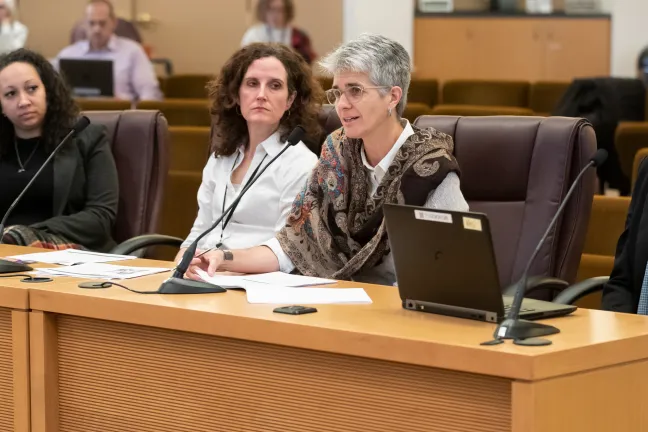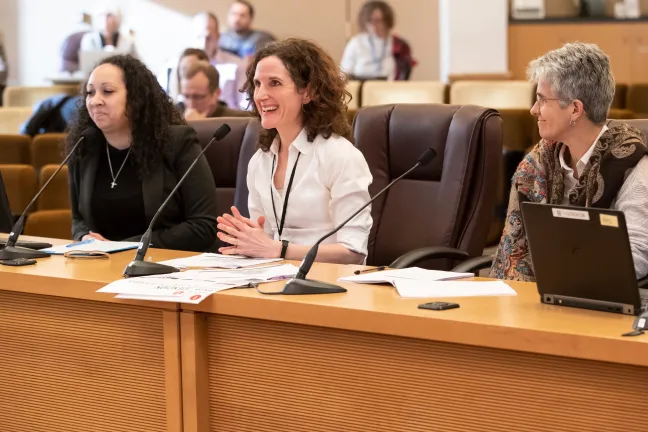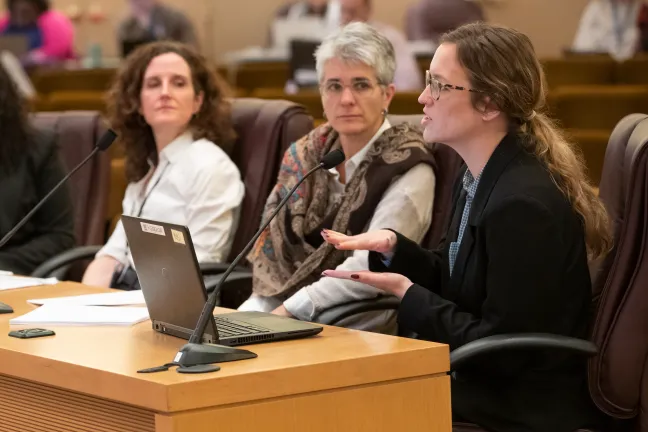A year ago, County Commissioners worked with the Health Department to maintain Harm Reduction services in the face of a budget deficit. As part of their commitment to Harm Reduction, commissioners asked Health Department officials to return with an assessment of syringe service needs in east Multnomah County.
On Tuesday, Public Health Director Rachael Banks joined Health Officer Dr. Jennifer Vines and Kim Toevs, director of Communicable Disease and Sexually Transmitted Disease Programs, to present those findings — and offer some context.
“With the one-time-only funds, we have been able to keep all service sites open and fully staffed, and maintained our level of supplies,” Toevs told the Board, saying the one-time-only funding also allowed for increased testing that showed an increase in HIV. “This was very helpful. It turned out to be really important.”
When diseases collide
Multnomah County, in fact, has seen an increase in at least three communicable diseases that are all transmitted though sex and injection drug use.
Dr. Vines introduced the concept of a “syndemic,” an increase in two or more diseases affecting the same population and acting together create a large burden of disease.
Multnomah County’s Public Health Division is trying to stop an ongoing syndemic primarily involving three diseases: HIV, syphilis, and Hepatitis C. All three are spreading among people who use methamphetamines and injection drugs, often men who have sex with men and often people who are unstably housed.
For much of the previous decade, advances in treatment and prevention made HIV transmission less likely. A new drug called PrEP protected HIV-negative people from contracting the virus. As HIV rates dropped, the State launched End HIV Oregon.
“Then you see 2018,” Vines told the Board. “The state and we came together around an unexpected uptick. The risk factors included IV drug use, meth use, and men who have sex with men.”
At the same time, health officials have also been tracking an increase in syphilis, two decades after disease rates had dropped to record lows. Men who have sex with men are most at risk, but officials are also seeing rates increase among pregnant women who are vulnerable to drug use, homelessness and domestic violence. Vines said that increase especially qualifies as a public health emergency. Untreated syphilis in fetuses can cause stillbirths and lifelong health problems for babies.
Finally the regional syndemic includes a rise in hepatitis C. Over a lifetime, untreated hepatitis C can cause liver damage or cancer. Screening recommendations for Hepatitis C have emphasized older adults. But in the last 10 yeas, the largest increase in disease rates has instead been among people younger than 40, Dr. Vines said.
“It’s a ripple factor of the opioid crisis,” she said. “Health officials anticipate a new generation of people with untreated Hepatitis C could contribute to the ongoing increase in liver disease and death.
“The good news is that there is a cure. For years treatment was expensive, with terrible side effects. That has completely changed.”
Harm Reduction
Local public health programs have invested heavily in campaigns to reach, educate, test and treat people at risk of HIV, syphilis and hepatitis C. It’s time-intensive, Vines explained, with a team of disease intervention specialists at times as outreach, community health and social service workers.
Commissioner Lori Stegmann asked how disease intervention staff notify people and their sexual or drug-use partners of an infection.
Health care providers and labs are required to report certain diseases to their local public health authority, Vines explained. In Multnomah County that’s the Health Department.
A team of disease intervention specialists finds innovative ways to reach people who test positive for these diseases but who may not have phones or fixed addresses, who might have trouble making a clinic appointment, or who have had poor experiences in health care where they felt judged or mistreated.
“They are often people who don’t trust the government,” Toevs said. “They have not been seeking engagement. So building rapport is important.”
Disease intervention specialists might connect with clients through social media or by visiting camps. They establish relationships with people in camps. They also offer health kits and coupons for free HIV testing to people they meet. When they find the person they’re seeking, they work together to contact partners and establish treatment and healthcare plans.
The longer-term solution is housing, Vines said.
“Housing is also prevention. Someone housed can be on a regimen,” she said. “When their HIV viral load is undetectable, they can’t transmit to others.”
But many people who use intravenous drugs first touch the health system at their local syringe exchange. In fact, Toevs told the Board, in East Multnomah County, about a quarter of people who visit a syringe exchange site have no other contact with health or social services.
To conduct its needs assessment, the east County syringe exchange program completed a comprehensive client survey and reviewed records related to where clients had received naloxone. Staff interviewed clients and conducted targeted street outreach and mapping.
Syringe exchange clients are increasingly using methamphetamine or combining meth and heroin. And more clients are experiencing homelessness than in prior years. Demand for syringe services is rising in Gresham, Toevs said.
Toevs pointed Commissioners to a map showing client numbers by ZIP code. By far, the map showed, the largest number of clients remain in east Portland, where the Harm Reduction Clinic and multiple syringe exchange sites are now located.
“Almost all my district is covered in that map,” Commissioner Jessica Vega Pederson said. “Thank you for having resources in that area where people can access them.”
Rethinking syringe exchange
Commissioner Susheela Jayapal asked Toevs for the difference between a needle exchange and other syringe services in Multnomah County.
Three entities provide clients with sterile syringes in Multnomah County, Toevs explained.
Staff from Multnomah County and Outside In (a nonprofit with funding from the County) operate syringe exchange sites
Under the exchange model, clients bring in their used syringes and receive approximately the same number of sterile syringes in return. But that model is falling out of favor with public health experts, Toevs told the Board.
“Needle exchange was the first model of service,” she said. “More nationally are moving to different models, need-based models.”
That’s the model used by the area’s third syringe services provide, Portland People's Outreach Project, or PPOP. The volunteer group provides syringes and other harm reduction supplies to people who use drugs.
PPOP is not funded by Multnomah County, although the County takes any used syringes the volunteer group gathers. PPOP operates a model of syringe distribution, rather than exchange.
Toevs said researchers have found that models emphasizing distribution over one-for-one exchanges can have a larger impact on reducing syringe sharing and unsafe injection practices. The Centers for Disease Control and Prevention are urging communities without exchanges to start them, while urging communities that already have exchanges to make syringes more accessible.
In a study of four cities operating syringe exchanges, the city that did not operate a strict one-for-one exchange reported a far higher percentage of people using syringes for a single injection, which is safer than reusing syringes for multiple injections. At the same time, evidence also suggests communities with distribution models don’t see more discarded syringes.
“That makes complete sense,” Jayapal said. “We want to encourage both. They don’t need to be linked.”
Stegmann, whose district includes Gresham, said she would be happy to help Harm Reduction staff build a relationship with law enforcement in the area as it considers locations for a new East County exchange site. “I’m looking forward to positioning ourselves to serve east county,” she said.
“You guys are heros. Thank you for the work you do,” said Chair Deborah Kafoury. “We learn from our past efforts and continue to grow and expand. This board is supportive of the work you're doing and we want to continue having these conversations.”



